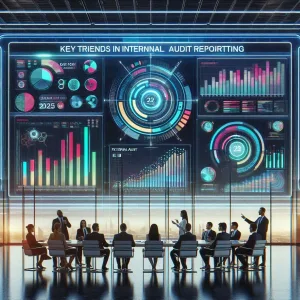In an increasingly interconnected business landscape, organizations are relying more than ever on third-party vendors to fulfill critical functions. This reliance brings with it a host of risks that can jeopardize an organization’s security, compliance, and overall operational integrity. Third-party risk management (TPRM) is a systematic approach to identifying, assessing, and mitigating these risks associated with external partners, including vendors, suppliers, and service providers. TPRM encompasses various risk types, such as cybersecurity threats, compliance violations, operational disruptions, financial instability, and reputational damage, each presenting unique challenges that organizations must navigate to maintain resilience and security in their operations[2][11]. For a comprehensive third party risk management policy PDF, organizations can refer to various online resources.
The importance of TPRM cannot be overstated in today’s business environment. With a significant percentage of organizations experiencing breaches attributed to third parties—74% in a recent report—effective TPRM practices are essential for safeguarding sensitive information and ensuring compliance with regulatory requirements [6]. As organizations face evolving risks, including those posed by emerging technologies like artificial intelligence, the need for robust TPRM policies becomes even more critical [4].
Internal audit plays a pivotal role in enforcing TPRM policies. Auditors are uniquely positioned to evaluate the effectiveness of TPRM frameworks, ensuring that organizations not only have policies in place but also that these policies are actively implemented and adhered to across all levels of the organization. By conducting thorough assessments of third-party relationships and their associated risks, internal auditors can provide valuable insights that help strengthen risk management practices. This includes identifying gaps in compliance, assessing vendor performance, and recommending improvements to enhance the overall TPRM strategy [1][9].
As organizations navigate the complexities of third-party relationships, the collaboration between internal audit and TPRM becomes essential. Auditors not only help enforce compliance but also contribute to the development of a resilient risk management culture that can adapt to the ever-changing landscape of third-party risks.
Understanding Third Party Risk Management Policies
In the realm of internal auditing, the enforcement of Third Party Risk Management (TPRM) policies is crucial for safeguarding organizations against various risks associated with external vendors and partners. This section aims to clarify the essential components of TPRM policies, the common risks involved, and the significance of having these policies documented, preferably in a PDF format for accessibility and standardization.
Components of a TPRM Policy
A comprehensive TPRM policy typically includes the following components:
- Risk Identification and Assessment: This involves outlining the processes for identifying and assessing risks associated with third-party relationships. It should detail how risks are categorized and prioritized based on their potential impact on the organization [5][8].
- Due Diligence Procedures: The policy should specify the due diligence required before engaging with third parties. This includes evaluating the financial stability, compliance history, and operational capabilities of potential vendors [4][10].
- Monitoring and Reporting: A robust TPRM policy must include guidelines for ongoing monitoring of third-party performance and risk exposure. This ensures that any emerging risks are promptly identified and addressed [3][14].
- Roles and Responsibilities: Clearly defined roles for internal auditors, risk managers, and other stakeholders are essential. This helps in establishing accountability and ensuring that all parties understand their responsibilities in managing third-party risks [1][7].
- Incident Response Plan: The policy should outline procedures for responding to incidents involving third parties, including communication strategies and remediation steps [9].
Common Risks Associated with Third Parties
Organizations face a variety of risks when engaging with third parties, including:
- Operational Risks: These arise from the potential failure of third-party services, which can disrupt business operations and lead to financial losses [4].
- Reputational Risks: Any negative actions or failures by a third party can adversely affect an organization’s reputation, leading to loss of customer trust and business opportunities [5][8].
- Compliance Risks: Third parties may not adhere to regulatory requirements, exposing the organization to legal penalties and compliance issues [3].
- Cyber Risks: With increasing reliance on technology, third-party vendors can become entry points for cyberattacks, jeopardizing sensitive data and systems.
Importance of Having a Documented TPRM Policy (PDF Format)
Documenting TPRM policies in a standardized format, such as PDF, offers several advantages:
- Accessibility: A PDF format ensures that the policy is easily accessible to all stakeholders, facilitating better understanding and compliance across the organization.
- Consistency: Having a documented policy helps maintain consistency in how third-party risks are managed, ensuring that all employees follow the same procedures and guidelines [5][14].
- Audit Trail: A formal document provides a clear audit trail, which is essential for internal auditors to review compliance and effectiveness of the TPRM practices [1][9].
- Ease of Updates: PDF documents can be easily updated and redistributed, ensuring that all stakeholders have the most current information regarding third-party risk management practices [12].
A well-defined TPRM policy is vital for organizations to effectively manage risks associated with third-party relationships. Internal auditors play a key role in enforcing these policies, ensuring that risks are identified, assessed, and mitigated in a structured manner. By understanding the components, risks, and importance of documented policies, auditors can significantly strengthen risk management practices within their organizations.
The Internal Audit Function
In the realm of third-party risk management (TPRM), the internal audit function plays a pivotal role in ensuring that organizations effectively manage risks associated with external vendors and partners. This section explores the responsibilities of internal auditors, their approach to assessing third-party risks, and the collaborative relationship they maintain with risk management teams.
Overview of Internal Audit Responsibilities
Internal auditors are tasked with evaluating the effectiveness of an organization’s risk management processes, including those related to third-party engagements. Their responsibilities encompass:
- Risk Assessment: Conducting comprehensive assessments to identify potential risks posed by third-party vendors, including financial, operational, and compliance risks [10].
- Policy Evaluation: Reviewing and ensuring adherence to established TPRM policies, which provide a structured approach to managing third-party risks [1].
- Audit Planning: Developing audit plans that focus on high-risk areas associated with third-party relationships, ensuring that resources are allocated effectively to mitigate potential threats [12].
How Internal Auditors Assess Third-Party Risks
Internal auditors employ a systematic approach to assess third-party risks, which includes:
- Vendor Risk Assessments: Performing audits of vendors’ processes, policies, and financial health to identify vulnerabilities that could impact the organization [5].
- Continuous Monitoring: Implementing ongoing monitoring mechanisms to track changes in the risk landscape, including shifts in regulatory expectations and emerging threats, such as those posed by advancements in technology like artificial intelligence [6][14].
- Reporting and Recommendations: Providing actionable insights and recommendations based on audit findings, which help organizations strengthen their TPRM practices and address identified risks [7].
The Relationship Between Internal Audit and Risk Management Teams
The collaboration between internal audit and risk management teams is crucial for a robust TPRM framework. This relationship is characterized by:
- Information Sharing: Regular communication between auditors and risk management professionals to share insights on risk assessments and emerging threats, fostering a comprehensive understanding of the risk environment [8].
- Integrated Risk Management: Working together to develop and refine TPRM policies that align with the organization’s overall risk management strategy, ensuring that all aspects of third-party risks are addressed [10].
- Joint Training and Development: Engaging in joint training sessions to enhance the skills and knowledge of both teams regarding TPRM best practices and regulatory requirements, thereby promoting a unified approach to risk management [9].
The internal audit function is integral to enforcing third-party risk management policies. By effectively assessing risks, collaborating with risk management teams, and ensuring compliance with established policies, internal auditors can significantly strengthen an organization’s risk management practices and safeguard against potential vulnerabilities associated with third-party relationships.
Strengthening TPRM Practices through Internal Audit
In the realm of third-party risk management (TPRM), internal auditors play a crucial role in ensuring that organizations effectively manage the risks associated with external vendors, suppliers, and service providers. By leveraging their expertise, auditors can significantly enhance TPRM practices through several key activities:
- Conducting Thorough Risk Assessments of Third Parties: Internal auditors should initiate comprehensive risk assessments to identify potential vulnerabilities associated with third-party relationships. This involves evaluating the financial stability, compliance history, and cybersecurity posture of vendors. By systematically assessing these risks, auditors can provide valuable insights that inform decision-making and risk mitigation strategies [4][8].
- Evaluating the Effectiveness of Existing TPRM Policies: It is essential for internal auditors to review and assess the current TPRM policies in place. This evaluation should focus on whether the policies are being adhered to and if they are effective in mitigating identified risks. Auditors can analyze the implementation of these policies, ensuring that they align with industry standards and regulatory requirements. This process not only helps in identifying weaknesses but also reinforces the importance of compliance within the organization [1][5].
- Identifying Gaps and Recommending Improvements in TPRM: Through their evaluations, internal auditors can pinpoint gaps in the existing TPRM framework. This may include insufficient documentation, lack of clear roles and responsibilities, or inadequate monitoring processes. By recommending targeted improvements, auditors can help organizations strengthen their TPRM practices. This could involve developing more robust governance documents, enhancing communication channels, or implementing advanced monitoring tools to track third-party performance and compliance [2][3][9].
Internal auditors are pivotal in reinforcing TPRM practices by conducting thorough risk assessments, evaluating the effectiveness of existing policies, and identifying areas for improvement. Their proactive involvement not only enhances the organization’s risk management framework but also fosters a culture of accountability and continuous improvement in managing third-party risks.
Audit Techniques for Effective TPRM Compliance
In the realm of third-party risk management (TPRM), internal auditors play a pivotal role in ensuring that organizations effectively manage risks associated with external partnerships. By employing specific audit techniques, auditors can significantly enhance compliance and strengthen overall risk management practices. Here are some practical techniques that can be applied to TPRM:
- Utilizing Data Analytics to Monitor Third-Party Performance: Data analytics serves as a powerful tool for internal auditors to assess and monitor the performance of third-party providers. By analyzing key performance indicators (KPIs) and risk metrics, auditors can identify trends and anomalies that may indicate potential risks. This proactive approach allows organizations to address issues before they escalate, ensuring that third-party engagements align with the organization’s risk appetite and compliance requirements. The integration of data analytics into TPRM processes enhances the ability to make informed decisions based on real-time data, thereby improving oversight and control [3][9].
- Implementing Continuous Auditing to Ensure Ongoing Compliance: Continuous auditing is an effective technique that allows internal auditors to maintain a constant check on third-party compliance with established policies and regulations. By conducting regular audits rather than relying solely on periodic assessments, auditors can quickly identify compliance gaps and areas for improvement. This approach not only enhances the effectiveness of TPRM but also fosters a culture of accountability among third-party providers. Continuous auditing ensures that organizations remain vigilant in their risk management efforts, adapting to changes in the regulatory landscape and evolving business needs [10].
- Creating a Feedback Loop for Continuous Improvement: Establishing a feedback loop is essential for fostering continuous improvement in TPRM practices. Internal auditors can facilitate this by gathering insights from various stakeholders, including risk managers, compliance officers, and third-party providers. By analyzing feedback and performance data, auditors can identify best practices and areas that require enhancement. This collaborative approach not only strengthens the TPRM framework but also encourages a culture of transparency and communication within the organization. Continuous improvement initiatives can lead to more robust risk management strategies and better alignment with organizational goals [5][7].
By implementing these audit techniques, internal auditors can significantly contribute to the effectiveness of third-party risk management policies. Their role in monitoring, assessing, and improving TPRM practices is crucial in safeguarding organizations against potential vulnerabilities associated with external partnerships.
Collaboration with Other Departments
In the realm of Third Party Risk Management (TPRM), the internal audit function plays a crucial role in ensuring that organizations effectively manage risks associated with third-party vendors, suppliers, and service providers. A well-structured TPRM policy is essential, and internal auditors can significantly enhance risk management practices through collaboration with various departments. Here are key points highlighting the importance of interdepartmental collaboration in TPRM:
- Working with Procurement, Legal, and Operational Teams: Internal auditors should actively engage with procurement, legal, and operational teams to ensure that TPRM policies are comprehensive and aligned with organizational objectives. Procurement teams can provide insights into vendor selection processes, while legal teams can help navigate regulatory requirements and contractual obligations. Operational teams can offer practical perspectives on how third-party relationships impact day-to-day operations. This collaboration ensures that the TPRM policy is not only robust but also practical and enforceable [3][7].
- Establishing a Communication Framework for Risk Sharing: Effective communication is vital for successful TPRM. Internal auditors should work to establish a communication framework that facilitates the sharing of risk-related information across departments. This framework can include regular meetings, shared reporting tools, and collaborative platforms that allow for real-time updates on vendor performance and risk assessments. By fostering open lines of communication, organizations can quickly identify and address potential risks associated with third-party engagements [1][9].
- Leveraging Expertise from Various Departments to Strengthen Policies: Each department within an organization possesses unique expertise that can contribute to the development and refinement of TPRM policies. For instance, IT departments can provide insights into cybersecurity risks, while finance teams can assess the financial stability of vendors. By leveraging this diverse expertise, internal auditors can ensure that TPRM policies are comprehensive and address a wide range of potential risks. This collaborative approach not only strengthens the policies but also promotes a culture of risk awareness throughout the organization [5][6].
The collaboration between internal audit and other departments is essential for enforcing effective third-party risk management policies. By working together, organizations can create a more resilient risk management framework that not only protects against external threats but also enhances overall operational efficiency.
Conclusion
In the realm of third-party risk management (TPRM), internal auditors play a pivotal role in ensuring that organizations effectively manage the risks associated with their external relationships. By independently reviewing, evaluating, and reporting on third-party practices, auditors can provide critical insights that enhance the overall risk management framework. This involvement not only helps in identifying potential vulnerabilities but also in fortifying the governance structures that underpin TPRM policies [6].
A proactive approach to risk management is essential in today’s interconnected business environment. As organizations increasingly rely on third-party vendors, the risks associated with these relationships can significantly impact reputation, financial stability, and compliance with regulatory requirements. Internal auditors must be well-informed about how third parties are selected and managed, as this knowledge is crucial for mitigating risks effectively [8]. By adopting a risk-based perspective, auditors can assess the maturity of existing TPRM processes and recommend improvements that align with best practices [10][11].
As we conclude, it is imperative for internal auditors and risk professionals to actively engage with TPRM policies. This engagement not only strengthens the organization’s risk management practices but also ensures that auditors are positioned as key contributors to the overall governance and compliance landscape. By taking the initiative to enhance TPRM practices, auditors can help safeguard their organizations against potential risks, ultimately fostering a culture of accountability and resilience [9][12].
In summary, the role of internal audit in enforcing TPRM policies is not just about compliance; it is about creating a robust framework that supports sustainable business operations. Auditors are encouraged to embrace this responsibility and lead the charge in strengthening third-party risk management practices within their organizations.
Find out more about Shaun Stoltz https://www.shaunstoltz.com/about/
This post was written by an AI and reviewed/edited by a human.



